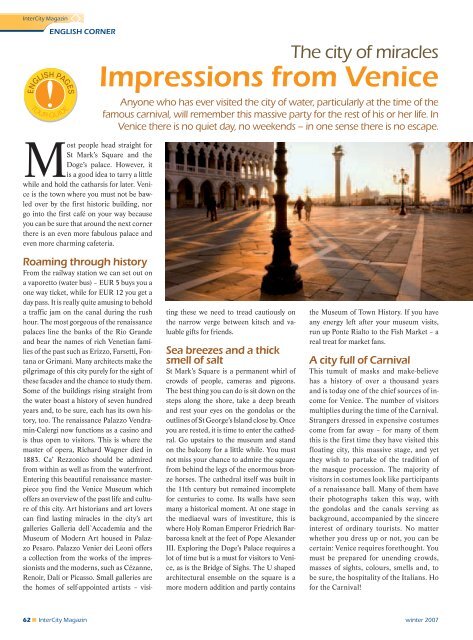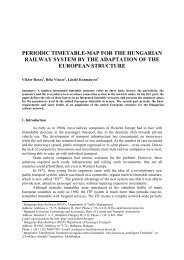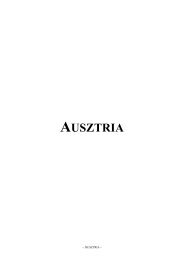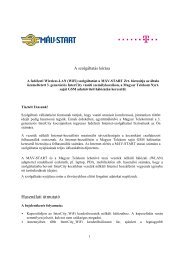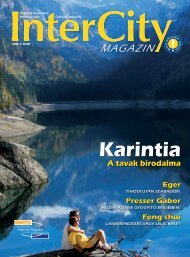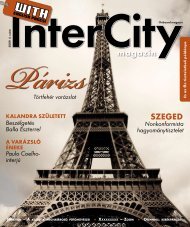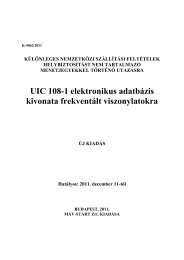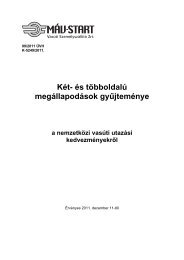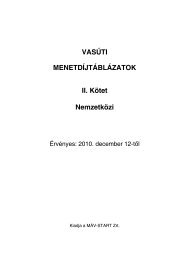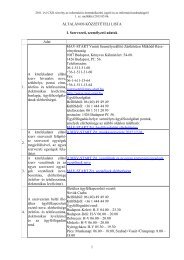Create successful ePaper yourself
Turn your PDF publications into a flip-book with our unique Google optimized e-Paper software.
InterCity Magazin<br />
ENGLISH CORNER<br />
ENGLISH PAGES<br />
Most people head straight for<br />
St Mark’s Square and the<br />
Doge’s palace. However, it<br />
is a good idea to tarry a little<br />
while and hold the catharsis for later. Venice<br />
is the town where you must not be bawled<br />
over by the first historic building, nor<br />
go into the first café on your way because<br />
you can be sure that around the next corner<br />
there is an even more fabulous palace and<br />
even more charming cafeteria.<br />
Roaming through history<br />
From the railway station we can set out on<br />
a vaporetto (water bus) – EUR 5 buys you a<br />
one way ticket, while for EUR 12 you get a<br />
day pass. It is really quite amusing to behold<br />
a traffic jam on the canal during the rush<br />
hour. The most gorgeous of the renaissance<br />
palaces line the banks of the Rio Grande<br />
and bear the names of rich Venetian families<br />
of the past such as Erizzo, Farsetti, Fontana<br />
or Grimani. Many architects make the<br />
pilgrimage of this city purely for the sight of<br />
these facades and the chance to study them.<br />
Some of the buildings rising straight from<br />
the water boast a history of seven hundred<br />
years and, to be sure, each has its own history,<br />
too. The renaissance Palazzo Vendramin-Calergi<br />
now functions as a casino and<br />
is thus open to visitors. This is where the<br />
master of opera, Richard Wagner died in<br />
1883. Ca’ Rezzonico should be admired<br />
from within as well as from the waterfront.<br />
Entering this beautiful renaissance masterpiece<br />
you find the Venice Museum which<br />
offers an overview of the past life and culture<br />
of this city. Art historians and art lovers<br />
can find lasting miracles in the city’s art<br />
galleries Galleria dell`Accademia and the<br />
Museum of Modern Art housed in Palazzo<br />
Pesaro. Palazzo Venier dei Leoni offers<br />
a collection from the works of the impressionists<br />
and the moderns, such as Cézanne,<br />
Renoir, Dalí or Picasso. Small galleries are<br />
the homes of self-appointed artists – visi-<br />
Anyone who has ever visited the city of water, particularly at the time of the<br />
famous carnival, will remember this massive party for the rest of his or her life. In<br />
venice there is no quiet day, no weekends – in one sense there is no escape.<br />
ting these we need to tread cautiously on<br />
the narrow verge between kitsch and valuable<br />
gifts for friends.<br />
Sea breezes and a thick<br />
smell of salt<br />
St Mark’s Square is a permanent whirl of<br />
crowds of people, cameras and pigeons.<br />
The best thing you can do is sit down on the<br />
steps along the shore, take a deep breath<br />
and rest your eyes on the gondolas or the<br />
outlines of St George’s Island close by. Once<br />
you are rested, it is time to enter the cathedral.<br />
Go upstairs to the museum and stand<br />
on the balcony for a little while. You must<br />
not miss your chance to admire the square<br />
from behind the legs of the enormous bronze<br />
horses. The cathedral itself was built in<br />
the 11th century but remained incomplete<br />
for centuries to come. Its walls have seen<br />
many a historical moment. At one stage in<br />
the mediaeval wars of investiture, this is<br />
where Holy Roman Emperor Friedrich Barbarossa<br />
knelt at the feet of Pope Alexander<br />
III. Exploring the Doge’s Palace requires a<br />
lot of time but is a must for visitors to Venice,<br />
as is the Bridge of Sighs. The U shaped<br />
architectural ensemble on the square is a<br />
more modern addition and partly contains<br />
The city of miracles<br />
Impressions from Venice<br />
the Museum of Town History. If you have<br />
any energy left after your museum visits,<br />
run up Ponte Rialto to the Fish Market – a<br />
real treat for market fans.<br />
A city full of Carnival<br />
This tumult of masks and make-believe<br />
has a history of over a thousand years<br />
and is today one of the chief sources of income<br />
for Venice. The number of visitors<br />
multiplies during the time of the Carnival.<br />
Strangers dressed in expensive costumes<br />
come from far away – for many of them<br />
this is the first time they have visited this<br />
floating city, this massive stage, and yet<br />
they wish to partake of the tradition of<br />
the masque procession. The majority of<br />
visitors in costumes look like participants<br />
of a renaissance ball. Many of them have<br />
their photographs taken this way, with<br />
the gondolas and the canals serving as<br />
background, accompanied by the sincere<br />
interest of ordinary tourists. No matter<br />
whether you dress up or not, you can be<br />
certain: Venice requires forethought. You<br />
must be prepared for unending crowds,<br />
masses of sights, colours, smells and, to<br />
be sure, the hospitality of the Italians. Ho<br />
for the Carnival!<br />
Kaposvár, the city of plane trees<br />
ENGLISH PAGES<br />
Walks in the heart<br />
of Somogy county<br />
Streets and houses seem to grow<br />
out of a forest in this county town<br />
of 70,000 inhabitants. The whispering<br />
rustle of trees is a natural<br />
accompaniment to walks in Kaposvár – the<br />
lovely sound is only hushed in the winter.<br />
For almost a century now this city has been<br />
referred to as flowery Kaposvár. Tradition<br />
is duty: even the awnings of the railway station,<br />
reminiscent of the Austro-Hungarian<br />
monarchy of the 19th century, are laden<br />
with pots of geraniums.<br />
There are no fewer than five InterCity trains<br />
running every day from Budapest to Kaposvár.<br />
This means that you can align your visit<br />
with theatre time and walk from the railway<br />
station straight to the performance of the<br />
famous Csiky Gergely Theatre right opposite.<br />
Indeed, this may be the best entry to this<br />
town – but be sure you book your theatre<br />
tickets well in advance as the repertoire attracts<br />
constant and intense attention. After<br />
the theatre, the best idea is to head for Fő<br />
utca (Main Street), which is the backbone<br />
of the city, and survey the menus of the restaurants.<br />
For your base you should choose<br />
Hotel Kapos on Kossuth Square or the famous<br />
old Hotel Dorottya. Both are about<br />
an equal distance from the station and serve<br />
as good points of departure for various<br />
visits to the more or less distant points of<br />
interest in Somogy county.<br />
The place where Csokonai<br />
walked<br />
Kossuth Square is dominated by the City<br />
Hall, this many-turreted building which is<br />
over a hundred years old. In its foreground<br />
we see Lajos Kossuth’s statue. Opposite the<br />
City Hall we find the Cathedral to Our Lady<br />
which received its Neo-Romanesque and<br />
Neo-Gothic elements in 1886. The latest addition<br />
to the square is a truly special fountain<br />
– you can simply walk over it! The key<br />
to the secret is that the fountain propels its<br />
water to great heights straight from the ornamental<br />
paving stones. An elegant meteorolo-<br />
gical pillar offers you information about the<br />
humidity, the temperature and the weather<br />
forecast – equipped with this you are ready<br />
to head for the slightly uphill main street (Fő<br />
utca). The first building of historic interest is<br />
Dorottya-ház built in the late 18th century.<br />
Once the centre of the estate management<br />
of Duke Esterházy, this fancy town house<br />
must have been the scene of the famous ball<br />
which poet Mihály Csokonai Vitéz also attended<br />
and made immemorial through the<br />
resulting epic comedy. The Esterházys were<br />
affluent and generous mentors of this city:<br />
the building of the one time Kapos Grammar<br />
School was built from a donation by<br />
Duke Pál Esterházy. The other really impressive<br />
building on the right hand side of the<br />
street is the one time County Hall which today<br />
houses the Rippl-Rónai Art Gallery.<br />
High art and events<br />
The festival season at Kaposvár starts with<br />
the end-of-winter Carnival held on Dorotytya’s<br />
Day. This is followed in March by the<br />
music and dance events of the Kaposvár<br />
Spring Festival. In May the city honours<br />
its famous painters József Rippl-Rónai; János<br />
Vaszary and Lajos Kunffy through the<br />
‘City of Painters’ Ambience Festival. In the<br />
summer a stage is built among the ruins<br />
of the Benedictine<br />
Monastery of Szentjakab,<br />
to house the<br />
Szentjakab Summer<br />
Nights series.<br />
Every two years this<br />
county town becomes<br />
the meeting<br />
point of Theatres<br />
for Children and<br />
Young People. Kaposvár<br />
is also the<br />
home of over two<br />
hundred junior football<br />
teams arriving<br />
for the Junior Football<br />
Festival – this is<br />
ENGLISH CORNER<br />
InterCity Magazin<br />
Streets and houses seem to grow<br />
out of a forest in this county town of<br />
70.000 inhabitants. The whispering<br />
rustle of trees is a natural accompaniment<br />
to walks in Kaposvár – the lovely<br />
sound is only hushed in the winter.<br />
the time when all the streets are crowded<br />
with children dressed in football clothes. If<br />
we arrive in the winter, the villa on Rómahegy<br />
still awaits us all, offering us a glimpse<br />
into the secret empire of the painter Rippl-<br />
Rónai, the temple of the figurative arts.<br />
The romantic county<br />
of Somogy<br />
To the North of Kaposvár we find Deseda<br />
Lake, a popular watering place with the people<br />
in the area. Its name is believed to come from<br />
the bridge over the river Dés. What is certain<br />
is that the lake, a result of a dyke in the stream<br />
Deseda, has fulfilled its mission to perfection<br />
– so much so that at present there are plans to<br />
build a leisure centre along the lakeside. Before<br />
we visit further points of interest in Kaposvár<br />
and Somogy county, we must not forget<br />
how close we are to Lake Balaton. It is worth<br />
our while visiting the South Bank of the lake<br />
even if we are out of the season – the beauties<br />
of the lake in winter are breathtaking.<br />
But now let us return to the county centre.<br />
Anyone might ask the question where is the<br />
‘vár’, the castle mentioned in the name of the<br />
city. Well, this mediaeval fortification, which<br />
once stood by the bank of the river Kapos,<br />
was not as fortunate as many other historic<br />
castles in Hungary.<br />
62<br />
InterCity Magazin<br />
winter 2007<br />
2007 winter<br />
InterCity Magazin<br />
6


